- Channel morphology is also called river channel morphology (or river morphology), it is a complete study of the channel from geography aspect to channel fluids dynamics aspect.
- The study of channel-related aspects like channel pattern, channel geometry and the factors controlling these forms is called as Channel Morphology. The factors that govern and affect the channel are the processes by which a channel is modified. The channel morphology also includes studying the network of tributaries that join to the main river channel within the drainage basin.
- Channel development is controlled by two factors:
- Water flow or discharge (in terms of volume and velocity)
- Sediment movement
- These two factors are governed by the channel slope or gradient. The channel gradient varies from steep to gentle slope depending on the altitudinal variation that a the channel is crossing by the mutual inter-relation of these parameters maybe qualitatively described by Lane’s Principle (also known as Lane’s relationship) that states the product of the sediment load and bed grain size is proportional to the product of discharge and channel slope.
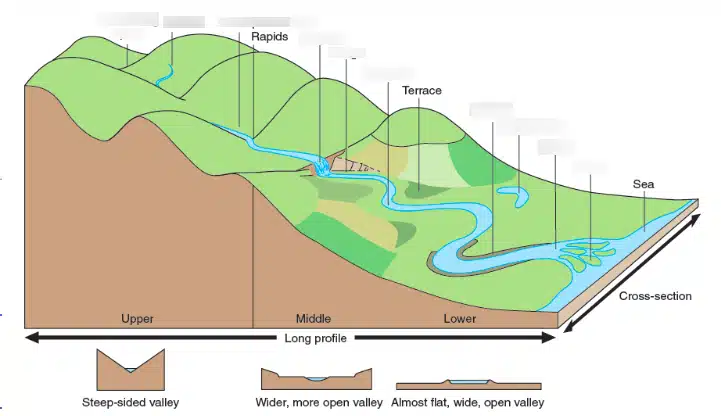
Channel
- The term channel is used in the context of defining the path of a water body that is narrow such as a river or a strait. Thus, in Physical Geography, Channel can be defined as the path of a river or a stream outlined by its bed and banks.
- The whole system of river channels with its joining branches in the form of tributaries that dissect the earth’s surface is in proportion to the valley size. Channels are occupied by permanent streams, those that flow throughout the year, some have intermittent streams and some have ephemeral streams, which are active only during and after the rains.
- Although the water of the river flows in its channel but during floods, the water flow exceeds the capacity of the channel and the water spills out of the channel over the floodplain causing the flood.
- The term channel is often taken as synonymous for the term strait that is defined as a relatively narrow body of water that connects two larger bodies of water. In this nautical context, the terms strait, channel, and passage are used interchangeably. For example, in an archipelago, the water between islands is typically called a channel or passage. For example, The English Channel is the strait between England and France.
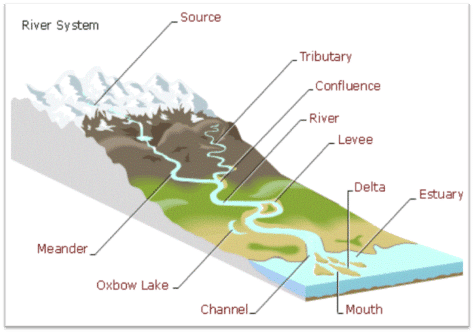
Channel Structure
- Channel Structure consists of channel banks, channel bed, and Thalweg.
- Channel Bed: the main path taken by the river, through which it flows, is called the channel bed.
- Channel Banks: the two sides of the river bed are called channel banks.
- Thalweg: It is a continuous line joining the lowest points in a stream channel.
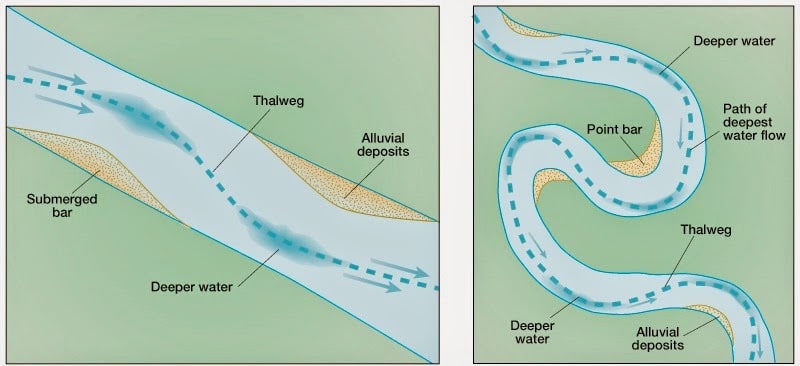
Thalweg Principle
- The thalweg principle (also known as the thalweg doctrine or the rule of thalweg) is the legal principle that if the boundary between two political entities is stated to be a waterway, without further description (e.g., a median line, right bank, eastern shore, low tide line, etc.), the boundary follows the thalweg of that watercourse.
- In particular, the boundary follows the center of the principal navigable channel of the waterway (which is presumably the deepest part). If there are multiple navigable channels in a river, the one principally used for downstream travel (likely having the strongest current) is used.
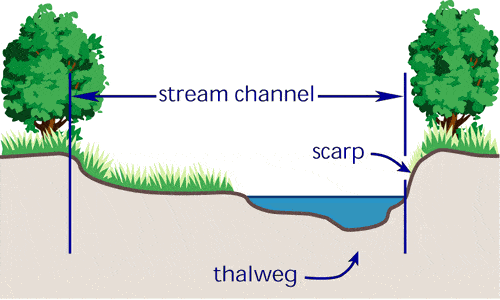
River Processes
- Erosion: the process of wearing something away. The river erodes in four main ways; attrition, corrosion, corrasion and hydraulic action.
- Corrasion (abrasion): The process of a rivers’ load crashing and rubbing into a rivers’ banks and bed causing pieces to break off.
- Corrosion (solution): The process of water dissolving a rivers’ load as well as its bed and banks.
- Hydraulic action: Water and air getting into cracks in a rivers banks and bed causing erosion through increased pressure is described as hydraulic action.
- Attrition: Load crashing into each other in a river. This normally happens with suspended load.
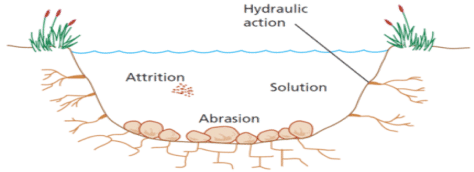
- Transportation: The river can transport material when it has excess energy. The river transports in four main ways; traction, saltation, solution and suspension. Material carried by a river is know as load.
- Traction: The process of large pieces of load rolling along a river bed.
- Saltation: The process of load bouncing a long a river bed.
- Suspension: The process of smaller pieces of load being carried in a rivers flow.
- Solution: The processed of dissolved pieces of material being transported in a solution.
- Flotation: When material is transported on the surface of the river.
- Load: Material that is transported by a river. If the material is being transported along the bed, it is known as bedload, load transported in a rivers flow is often called suspended load.
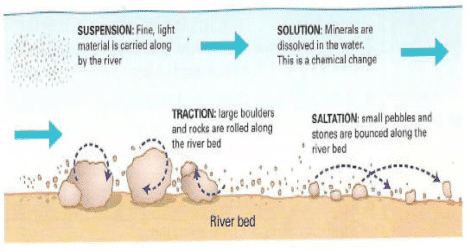
- Deposition: When a river does not have enough energy, it will start depositing its loads. Deposit means to put something down.
Factors Controlling Channel Morphology
There are two sets of factors that control channel morphological aspects such as channel pattern and channel movement:
Independent Factors:
- These are the factors that are imposed on the watershed. These are related to landscape aspects and control channel morphology such as geology, climate, and human.
- The geology of a watershed is determined by processes acting at the landscape and can include endogenic processes such as volcanism, tectonics, and, to a lesser extent, surface processes such as erosion and deposition. Within a watershed, these processes control the distribution, structure, and type of bedrock, surficial materials, and topography (Montgomery 1999).
- Climate is also regarded as an independent factor at the landscape scale as it is decisive in controlling the amount of rainfall and water flow in the stream channel.
- Human actions on the landscape can also significantly alter the watershed conditions.
- The geologic, climatic, and human conditions to which a watershed is subjected determine the dependent landscape variables of sediment supply, stream discharge, and vegetation (Montgomery and Buffington 1993; Buffington et al. 2003). An additional important independent variable is time.
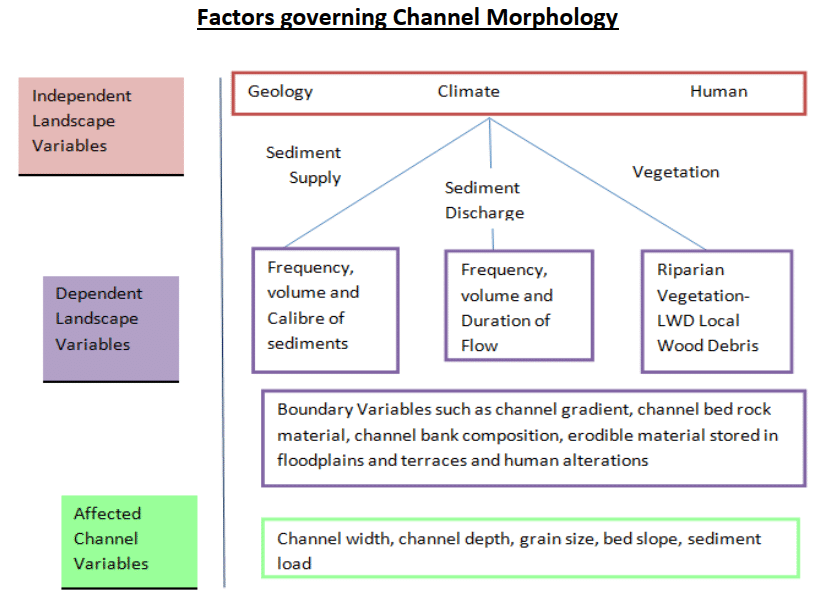
Dependent Factors:
- These are those variables that respond and adjust to the independent conditions. Channel morphology is the result of the combined influence of these dependent landscape variables, and the channel responses to changes in these variables by adjustments in one or many of the dependent channel variables.
- Sediment supply is determined by the frequency, volume, and calibre of material delivered to the channel. Stream discharge includes the frequency, magnitude, and duration of stream flows.
- The variability in stream discharge both temporally and spatially exerts a large influence on channel morphology.
- The third variable that influences channel is riparian vegetation as that controls bank erodibility as well as near-bank hydraulic conditions, and is also a source of in-channel large woody debris (LWD).
- Classic models depicted channel morphology as primarily a function of stream flow and sediment transport rate, where transport rate equals sediment supply for equilibrium conditions (e.g., Schumm 1971).
- But these models did not explain the role of vegetation or other boundary conditions, which plays a crucial role in determining channel morphology.
- Besides, riparian vegetation, important boundary conditions include elements found within the stream channel, as well as those that may influence the channel’s ability to migrate laterally and (or) build vertically.
- The most important boundary conditions include:
- Channel gradient that is controlled by valley slope, as the maximum possible gradient that a stream channel can have is dependent on valley slope.
- Bank composition and structure, which influence bank erodibility as determined by the sedimentology and geotechnical properties of the material bounding the channel
- Bedrock and other non-erodible units (such as colluvial material, compact tills, and lag glaciofluvial deposits), which may limit lateral and vertical channel migration and determine stream channel alignment.
- Erodible sediment stored in valley bottoms in floodplains, fans, or terraces (including alluvial sediments; lacustrine, marine, and glacial outwash deposits; and fine-textured colluvium)
- Human channel alterations, such as bridge crossings, and flood protection works. These boundary conditions are primarily influenced by the geomorphic history of a landscape, as well as the history of human intervention. The current morphology of a stream is, therefore, a product of both present-day and historic watershed processes.
Channel Classification
- The channels can be classified into different categories based on different criteria. These criteria include the constituent material of the river channel and the shape or pattern of the river channel. The pattern of the channel is described as channel form. Channels exist in a variety of forms. There are a wide variety of stream channel types based on their forms, such as Single Thread Sinuous Rivers, Wandering Rivers or a meandering river, Braided Rivers, etc. enclosed by the materials of its bed and banks.
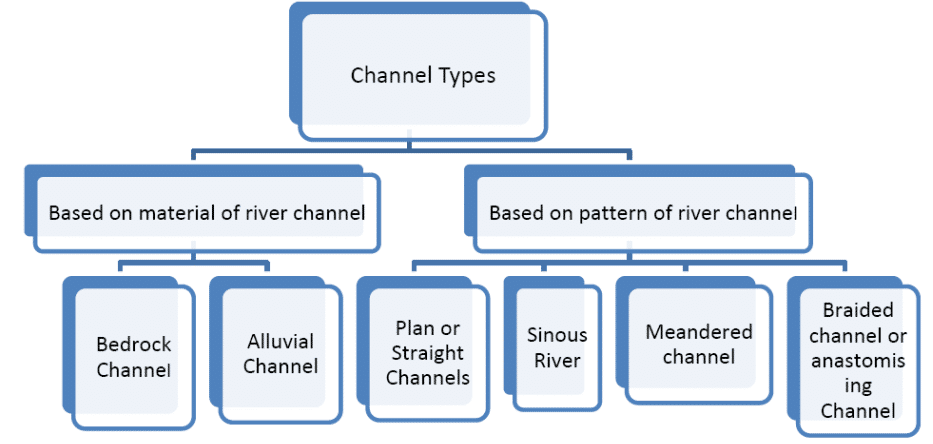
- Bedrock Channel: When the river bed has the cover of rocks rather than the sediment cover and the river erodes into the rock. These are the channels that flow through non-erodible materials (e.g., bedrock, coarse colluvium, and non-erodible glacial deposits) and their boundary conditions tend to dominate the channel morphology. This type of channel usually has a limited sediment supply and a morphology that is largely determined by the structure and composition of the material through which it flows. Bedrock channels, for example, frequently run along faults or other geologic planes of weakness within the rock. Overall, these channels are relatively insensitive to disturbances, including disturbances from changes occurring upstream (i.e., the channel is relatively stable), but bedrock channels are very effective at transferring disturbances from upstream to downstream reaches.
- Alluvial Channel: When the river cuts the river-transported rock debris, or alluvium, these are referred to as the alluvium channel. These channels are more regular.
- Schumm (1985) has proposed a more detailed channel classification that included three categories:
- bedrock channel,
- semi-controlled channel, and
- alluvial channel;
- But this classification was found to be not addressing the variable geotechnical properties associated with the landforms.
- So Kellerhals in 1976, has suggested that the categories should be based on the materials that determine channel bed and bank strength and the channel’s threshold of erodibility. Based on this, three categories of materials constituting channel could be identified (1) nonerodible, (2) semi-erodible, and (3) erodible. Although, these terms (as opposed to the conventional “non alluvial” and “alluvial”) are more useful, but by definition these are contradictory, as all alluvial material is erodible and many non-alluvial materials are also highly erodible (e.g., marine and glaciofluvial deposits). Similarly, some alluvial materials are far less erodible than others; for instance, armored channel beds developed by fluvial processes are much more resistant to movement than other alluvium such as gravel-bar deposits, which are rearranged on an annual basis.
- The other classification is based on the shape assumed by the river channel, called a planform pattern. In the words of Leopold (1957) “Channel pattern is used to describe the plan view of a reach of river as seen from an airplane and includes meandering, braiding, or relatively straight channels. Natural channels characteristically exhibit alternating pools or deep reaches and riffles or shallow reaches, regardless of the type of pattern.” The shape of the channel is largely decided by the sinuosity of the river. Sinuosity refers to the ratio of the measured channel distance divided by the straight-line distance of the valley from the beginning of the channel reach to the end of the channel reach.
- Mollard (1973) identified 17 planform channel types that were related to both the physiographic environment in which channels flowed, and the materials that made up the channel bed and banks. He based this channel pattern classification on the factors controlling morphology, specifically streamflow, sediment supply, the relative dominance of fluvial transport processes, and the materials within which the channel is formed.
- Church (1992) classified channel patterns on the basis of the caliber and volume of sediment supply that in turn decides the sinuosity of the river channel. He has separated the patterns into phases of river channel flow during its upper course to lower course, related to how the supplied sediment gets transported.
- On a more simplistic scale, channels can be categorized into four types, based on the pattern taken by the river channel
- Straight River Channel: For channels with moderate-sized bed material (such as gravel-bed streams), channels with moderate sediment supply usually have a “straight river channel”.
- Sinuous River Channel: As the channel bends slightly with the increase in the sediment load, the channel is called the “sinuous river channel”.
- Meandering River Channel: As the supply of sediments exceeds the channel’s capacity to transport the additional sediment, the channel may take a zig-zag shape called as “meandering channel”. The channel may break into two or more individual channels. When the channel is not too active it can divide and recombine around stable, vegetated islands; these are called wandering channels.
- Braided River Channel: In other situations, the channel becomes too active for stable vegetated islands to develop, and the system divides into numerous individual channels that divide and recombine around unstable gravel bars; these are called “braided channels.” Anastomosing rivers or streams are similar to braided rivers in that they consist of multiple interweaving channels but they typically consist of a network of low-gradient, narrow, deep channels with a stable bank.
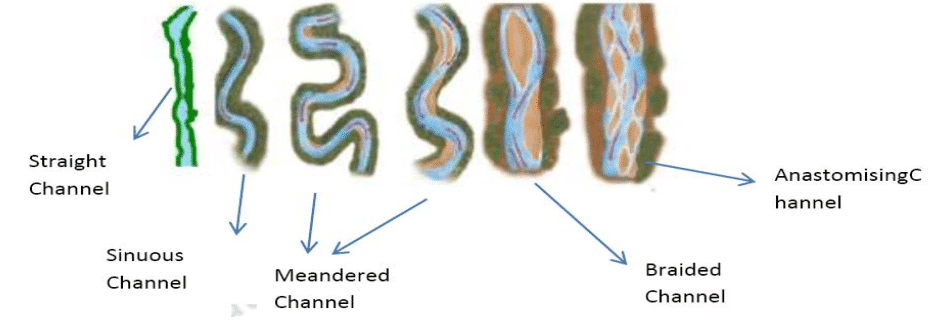
Hydraulic Geometry of Channel
- The analysis of the relationship among stream discharge, channel shape, sediment load and slope, has been called as hydraulic geometry of stream channels.
- Gaging stations around the world maintained by the respective governments make recordings along the rivers all over the world. At these stations, the water surface level, channel shape, stream velocity, amount of dissolved and suspended minerals and other variables are periodically recorded. These records provide a detailed history of river flow.
- In 1953, L.B.Leopold and Thomas Maddock published an elaborate analysis of thousands of measurements from stream gaging stations all over the world. It was they who called their analysis of the relationship among stream discharge, channel shape, sediment load and slope as hydraulic geometry of stream channels.
- To understand the hydraulic geometry of stream channels there is need to study the changes in following four parameters at different gaging stations under varying conditions spanning from low flow to bank full discharge and flood:
- Channel width,
- Channel depth,
- Stream velocity,
- Suspended load
- These four parameters increases as some small, positive power function of discharge, based on the following equations:
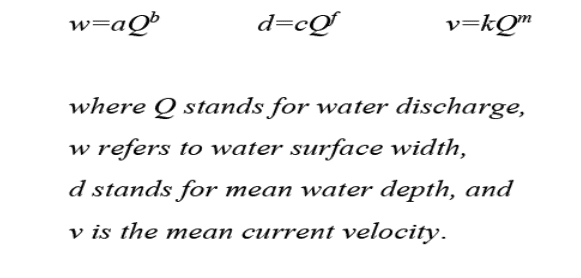
- The numerical values for arithmetic constants a, c, and k is not very significant for the hydraulic geometry of stream channels. They are constants of proportionality that convert a given value of discharge into the equivalent values of width, depth and velocity. The numerical values of the exponents b, f and m are very important as they describe the changes of width, depth and velocity for a specified change of discharge are very important.
- During flood, the water rises and stream channel width, depth and current velocity all increase at the gaging stations. This is clearly evident during the flood situation, as the regularity of the average changes drastically.
- In a downstream direction, the changes in channel shape and stream velocity are more significant as was emphasised by Leopold and Maddock in 1953. River discharge in humid area increases downstream.
- They proved that as mean discharge of a river increases downstream, channel width, channel depth, and mean current velocity all increase.
- Leopold and Maddock showed that not only the effluent rivers get both wider and deeper as they grow larger downstream but against the popular belief they also proved that average current velocity and increases downstream. This is because of the high-velocity current in a upper coarse of the river flows in circular eddies, with backward as well as forward motion.
- The numerical value of the three exponents b, f, and m that describe the variations in width, depth and velocity with variable discharge at gaging station are not the same as those that describe the downstream increases in width, depth, and velocity with progressively increasing mean annual discharge.
- Leopold and Maddock said that in a downstream direction, at mean annual discharge, the average values for the exponents were found to be B=0.5, f=0.4, and m=0.1.
- These values show that channel width increases most rapidly with mean annual discharge (as the square root of the discharge), depth next most rapidly, and mean velocity increases only slightly, in the downstream direction.
- Leopold and Maddock proposed that the increasing depth downstream permits more efficient flow in a river and compensates for the decreasing slope, thus providing a slight net increase in velocity at mean annual discharge.
- Thus, the channel width, depth, and velocity change with the streamflow, and against the popular belief, the velocity increases though only slightly in the downstream direction.
Channel Stability and Movement
- “Channel Stability” refers to channel’s propensity for vertical or lateral movement (Church 2006). Channel stability keeps on changing as the sediment gets deposited or gets carried away.
- These deposits can be either on the banks of the stream or in-channel deposits resulting into alterations in channel patterns. Detectable changes in channel pattern indicate important changes in both the watershed and the factors controlling morphology.
- Researchers can use the evidence of channel changes, as prepared by a geomorphologist, as an indicator of the environmental health of the watershed.
- Each channel type responds differently to changes in sediment supply or discharge. These responses can be of two types, including either vertical shifts (aggradations or degradation, as visible in the upward or downward position of the channel bed) and/or lateral shifts (sideways movement of the bed and banks, evident by old or abandoned channels on a floodplain).
- Vertical Channel shifts:
- Channel width-to-depth ratio keeps on changing along with the variation in the sediment load vis-à-vis transportation capacity. As there comes increase in sediment supply beyond the transport capacity of the river, sediments tend to get deposited, this is referred to as aggradation.
- It leads to an increase in the width-to-depth ratio of the channel and the level of channel stability decreases. This is clearly visible in the aerial view of river channel, where one can find an increase in the size and extent of sediment depositions within the channel overtime.
- In the cases where the sediment supply is less than the transportation capacity of the river, sediments are washed away, this results in degradation of channel.
- Lateral channel movement:
- Displacement of the channel laterally across a valley flat surface also indicates variations in the conditions upstream. Lateral movement is often caused by either progressive bank erosion or channel avulsion.
- Progressive bank erosion is the result of sediment aggradation within the channel or can occur simply from natural meandering processes.
- Whereas unlike channel erosion, channel avulsion is usually a relatively sudden and major shift in the position of the channel to a new part of the floodplain (called as first order avulsion), a sudden re-occupation of an old channel on the floodplain (known as second-order avulsion), or a relatively minor switching of channels within a braided channel or other similarly active channels (third-order avulsion) (Nanson and Knighton, 1996).
- Lateral channel movement influences the riparian zone (i.e., the interface between land and a river or stream), eroding some areas and building up others. The channel’s boundary conditions and the relationship between the stream and the valley through which it flows will determine the limit of lateral channel movement. If there are no constraints imposed, such as valley confinement, bridges, or dykes, and the valley flat is filled with erodible material, then the channel is usually capable of eroding across the entire extent of its floodplain.
- Wherever valley width exceeds channel width, a potential for lateral channel movement exists, and in confined systems in which the valley is only marginally wider, the extent of lateral movement is limited.
- In forested valleys, the additional bank strength provided by riparian vegetation can limit lateral channel movement and enable stable channel morphology to exist in an environment in which it otherwise may not occur.
- Changes in the patterns of in-channel sediment storage in bars and islands are also an early indicator of future channel problems.
- Braided channels are amongst the most active of all the stream channels, characterized by rapid lateral migration rates, and often undergoing net vertical aggradation.

Amazing.pls dont remove these pages.whenever im confused or dont have access to notes or books…i search here and always find content. Im assured that lotus would have content on any such topic.
many people must have trusted you guys like me, dont lose it.
Okay Ankit, Keep reading & Happy learning.
Language is pretty simple and convenient,only animation and videos a bit required for better understanding
Jump on the Youtube Baba and watch the relevant videos!
Are these notes enough for upsc optional ?
Yes
Most authentic and valuable explanation
Geography optional has been made is by lotusarise.com
its a great platform of learning…..more than any coaching institute anywhere in india…
can you provide pdf format of channel morphology
Good 😊
Best website on geography in the world.